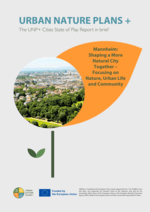
Mannheim State of Play report in brief
Read Mannheim’s State of Play Report summary to discover its journey towards becoming a nature- and climate-neutral city. Through initiatives such as the...
Read more
Situated at the confluence of the Rhine and Neckar rivers, Mannheim is renowned for its grid layout, industrial heritage and cultural diversity. However, in recent years, this city in the state of Baden-Württemberg has embarked on a new journey, aiming to become more liveable, nature-friendly, and climate-resilient. Mannheim's vision combines climate protection, biodiversity and social justice. It's about more than just new parks or trees. The city's vision is to create an urban ecosystem where people, nature and city planning work together.
Through initiatives such as the Local Green Deal and the Municipal Biodiversity Strategy, Mannheim is on the path to climate-neutrality by 2030, with the aim of making the city more liveable, resilient, and in closer harmony with nature.
Mannheim is not a metropolis full of boulevards; it is a city shaped by industry, traffic and residential areas. This is precisely where creative ideas for new open spaces arise. Former industrial sites are being transformed into natural corridors and streets are being redesigned to provide shade. The Rhine and Neckar rivers are key factors in climate adaptation and biodiversity.
Around 50% of the city area already consists of parks, forests and wetlands, ranging from the expansive Luisenpark and Herzogenriedpark to the new 80-hectare nature reserve on the former Spinelli site. This creates valuable habitats for people and nature in the heart of the city. Mannheim is using these areas to reconnect nature, city life and infrastructure.
Citizen participation is central to the city’s initiatives. Mannheim embraces the concept of co-creation, involving citizens, NGOs, scientists and municipal departments in planning processes from an early stage. Workshops, online platforms and public discussions bring together a wide range of perspectives.
But what does this look like in everyday life? The Participation Advisory Board is a permanent body that ensures the quality of citizen participation and considers different viewpoints. Projects such as the Local Green Deal and biotope network planning demonstrate how diverse groups can actively contribute to shaping the city, ranging from municipal departments and conservation organisations to citizens who contribute their own ideas.
Participation extends far beyond the design process itself: those who participate develop a sense of responsibility and experience first-hand how their ideas are transformed into concrete changes in the cityscape. In this way, urban nature is not only created, but lived too.
Mannheim is doing more than just building new parks and planting a few trees. The city is evolving into a laboratory for urban sustainability, combining dense development, diversity and industrial influence with ample potential for ecological transformation.
To realise this vision, the city is working on several levels at once:
This requires long-term financing, effective cooperation and an administration that considers climate protection and urban development as interconnected issues.
Mannheim is undergoing a transformation and has set itself ambitious goals: achieving climate neutrality by 2030, increasing biodiversity, and encouraging citizens to play an active role in shaping the city.
With support from the UNP+ project, the city can benefit from the experience of others and further develop its own ideas. Through initiatives such as the Local Green Deal, the Municipal Biodiversity Strategy, and the biotope network, a new Mannheim is emerging: one that is nature-oriented, vibrant, and socially just.
If these plans succeed, Mannheim will demonstrate that even an industrial city can become a climate-resilient, nature-friendly living space. It will be a city where parks, tree-lined streets and riverbanks are as much a part of everyday life as trams and housing and where the urban community actively shapes its surroundings. It would be a city that shows that more nature in urban areas is not a utopia, but possible — when everyone works together
Publishing date: